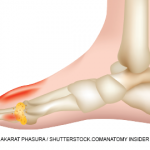He was prescribed 50 mg per day of allopurinol, and his dose was increased to 100 mg per day after one month until his next clinic visit. Based on a strong recommendation in the guideline to start anti-inflammatory prophylaxis, the patient also began taking colchicine at 0.6 mg per day.

Dr. Ted Mikuls
“How long should this patient remain on urate-lowering therapy? As a conditional recommendation, we recommend continuing urate-lowering therapy indefinitely over stopping urate-lowering therapy,” said Ted. R. Mikuls, MD, MSPH, Umbach Professor of Rheumatology at the University of Nebraska Medical Center and a rheumatologist at the Omaha Veterans Administration Hospital. “How long should this patient remain on colchicine prophylaxis? We strongly recommend continuing prophylaxis for at least a three-to-six-month period rather than less than three months, with ongoing evaluation, and to continue prophylaxis as needed if the patient continues to experience gout flares.”
What lifestyle management changes should a physician suggest for this patient moving forward? Based on conditional recommendations for patients with gout at any level of disease activity, physicians shouldsuggest that he limit alcohol, purine and high-fructose corn syrup intake and lose weight, but not adding vitamin C supplementation, said Dr. Mikuls.
‘We don’t have randomized trials to address every single clinical question of relevance. We need to be able to look at other evidence to help develop actionable guidelines.’ —Dr. Neogi
In another clinical scenario, a 58-year-old African American man presented to the clinic for ongoing management of his advanced gout. Three weeks after he started allopurinol therapy years ago, he experienced generalized rash, fever, eosinophilia and acute kidney injury, said N. Lawrence Edwards, MD, MACP, MACR, vice chair, graduate medical education at the University of Florida, Gainesville. The patient had no ULT for the next 14 years. His joint pain progressed. He had frequent gout flares and developed multiple tophi. He experienced gout flares every six to eight weeks. At presentation, he had low-grade synovitis in his wrists and ankles and a serum urate of 10.8 mg/dL, and his hand X-rays showed extensive erosive changes.

Dr. Edwards
“Should this patient be started on a ULT? Well, you can see that he checks all the boxes for strong recommendations for starting a ULT: he has one or more subcutaneous tophi, he has radiographic damage illustrated on any modality, and he has frequent flares,” said Dr. Edwards. “Which ULT should he start? Well, he is not going to go back on allopurinol, so febuxostat. In this case, there is a strong recommendation for at starting at a low dose with subsequent dose titration to a target over starting at a higher dose and staying there.”


